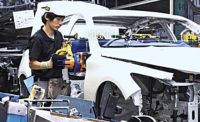Daimler, the company that created the world’s first gasoline-powered motorcar back in 1886, is planning for an all-electric future.
“[Electric vehicles] require [large] investment and high variable cost at the beginning of the journey,” says Ola Kallenius, CEO of Daimler AG. “But, at very rapid speed, we are scaling, developing and evolving technologies. We think we can [reduce] the variable cost significantly over the next five to 10 years, while increasing efficiency.”
Kallenius made his remarks during the recent Reuters Automotive Summit, a virtual event that featured many top executives from the auto industry. He believes major changes will occur over the next decade on the manufacturing side of the business. That’s because the typical electric vehicle only contains about 200 components in its battery and motor. By comparison, a traditional internal combustion engine and transmission requires at least 1,400 parts.
“The biggest transformation [occurring in our factories] is on the powertrain side,” claims Kallenius. “We will have a fundamental change in the industrial footprint that will require a 10- to 20-year journey. But, vehicle assembly will still be the same whether we put a combustion engine or an electric drive in it.”
Kallenius also outlined Daimler’s ambitious Vision EQXX. The goal of the “moonshot” R&D program is to develop an electric vehicle that can drive from Stuttgart to Marseille (more than 580 miles) on a single charge.
“We are challenging our engineers with a difficult task and an overly-ambitious target,” explains Kallenius. “However, this is not a PR stunt. We’re looking at what technologies could significantly improve the efficiency of an electric car. We are even involving our Formula One race team engineers in the project. We hope to be able to use some of those technologies when we introduce future electric architectures for [passenger vehicles].”
It’s all part of Daimler’s Electric First strategy that aims to expand the company’s electrified portfolio to more than 50 percent of global sales by 2030. As a result, Kallenius says investments in combustion engine development will decline quickly and the number of combustion engine variants will fall by 70 percent by the end of this decade.
Daimler’s flagship Mercedes-Benz division soon plans to launch four all-new electric vehicles based on its upcoming large-car electric vehicle architecture (EVA). The EQS luxury sedan will be vehicle using the EVA when it reaches the market in 2021 with a range of more than 700 kilometers. It will be followed by the EQE, the EQS-SUV and the EQE-SUV.
Daimler plans to produce those new vehicles at six global sites, backed by a network of nine battery assembly plants at seven locations in Asia, Europe and North America.
“We are in the process of investing more than $1 billion to expand our Vance, AL, factory to build a new generation of electric SUVs,” says Kallenius. The investment includes a new battery assembly plant in Woodstock, AL, that will ramp up by late next year.
Starting in 2025, many additional models will be added to Daimler’s portfolio using a second all-new dedicated electric platform, the Mercedes-Benz modular architecture designed for compact- and medium-sized cars.
According to Kallenius, Mercedes-Benz will shift even more of its product development resources and expertise to electric drive, and will invest in new technologies and concepts to accelerate electric range and efficiency. Its next generation of electric motors are being dveloped in-house and will feature sophisticated inverter and high-voltage technology.
In addition, Kallenius says Daimler is making huge strides in battery technology with in-house R&D programs complimented by close partnerships with key strategic partners such as Contemporary Amperex Technology Co., Farasis and Sila Nanotechnologies Inc. New materials and production processes are being developed to increase range, reduce charging time and reduce cost.
And, it’s not just electric cars. Daimler is also ramping up production of electrified buses and trucks, including U.S. brands such as Freightliner, Thomas Built and Western Star. For instance, Thomas Built Buses Inc. has been assembling Saf-T-Liner C2 Jouley vehicles at its plant in High Point, NC.



